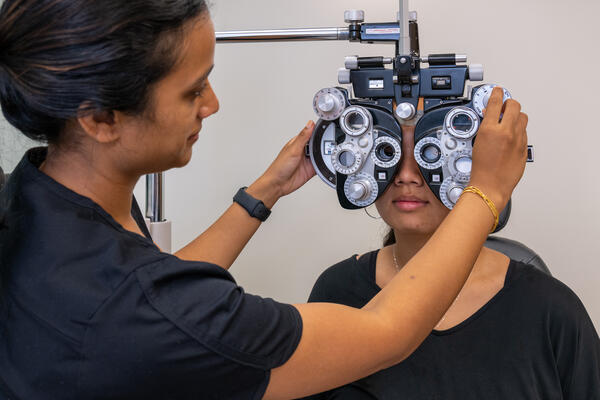Andalusia Eye Facility: Premier Services for Vision Modification
Wiki Article
The Advantages And Disadvantages of Various Refractive Surgeries for Improved Eyecare

LASIK Surgery
LASIK surgical treatment is a frequently done refractive treatment that intends to remedy vision issues such as farsightedness, nearsightedness, and astigmatism. This surgical strategy has gotten popularity because of its efficiency in offering patients with more clear vision and minimizing their reliance on glasses or get in touch with lenses. During the treatment, a thin flap is developed on the cornea, and a laser is used to improve the underlying tissue, correcting the refractive error. The flap is after that rearranged, permitting fast healing and marginal pain for the person.One of the key advantages of LASIK surgical treatment is the fast improvement in vision experienced by numerous individuals. The majority of individuals observe a substantial enhancement in their vision soon after the procedure, with minimal downtime required for healing. In addition, LASIK is understood for its high success price and low incidence of issues when performed by skilled specialists. Nevertheless, like any procedure, LASIK additionally brings some dangers, consisting of completely dry eyes, glow, halos, and under or overcorrection of vision. It is crucial for people considering LASIK surgical procedure to go through a detailed assessment by an eye treatment specialist to figure out if they are appropriate prospects for the treatment.
PRK Treatment
The PRK procedure, additionally known as Photorefractive Keratectomy, is a type of refractive surgical treatment that aims to deal with vision problems comparable to LASIK surgical treatment. Unlike LASIK, which entails creating a flap in the cornea, PRK works on the surface layer of the cornea.Among the benefits of PRK over LASIK is that it gets rid of the threat of flap-related difficulties given that no flap is developed throughout the surgical treatment. This can be valuable for individuals with thin corneas or those involved in call sporting activities where eye trauma is an opportunity. The healing time for PRK is typically longer contrasted to LASIK, as the external layer of the cornea needs time to regrow after the treatment. In spite of the longer healing period, PRK can be a suitable alternative for people seeking vision adjustment surgery.
SMILE Surgery
An innovative refractive surgery strategy obtaining appeal in the field of ophthalmology is SMILE Surgical treatment. Small Incision Lenticule Extraction (SMILE) is a minimally intrusive treatment that corrects vision by improving the cornea utilizing a femtosecond laser. Unlike traditional LASIK surgery, SMILE Surgical procedure involves creating a little incision in the cornea to extract a lenticule, which leads to much less interruption to the corneal structure and potentially much faster recuperation times.One of the main benefits of SMILE Surgery is its capability to treat myopia (nearsightedness) and astigmatism with high accuracy, bring about excellent aesthetic end results for clients. The minimally invasive nature of the treatment additionally reduces the risk of issues such as completely dry eye disorder, making it a favorable option for people looking for refractive surgery.

LASEK Technique
Having discovered the benefits and factors to consider of SMILE Surgical treatment, another noteworthy refractive surgery method worth examining is the LASEK Method. LASEK, which stands for Laser-Assisted Subepithelial Keratectomy, is a type of laser eye surgery that aims to deal with refractive mistakes such as myopia (nearsightedness), hyperopia (farsightedness), and astigmatism.Unlike LASIK, LASEK does not entail developing a corneal flap. Rather, throughout a LASEK treatment, the specialist makes use of a watered down alcohol remedy to loosen the slim external layer of the cornea, recognized as the epithelium. This layer is then gently relocated apart to enable the laser to improve the underlying corneal tissue. As soon as the cornea has actually been reshaped to the wanted degree, the epithelial layer is rearranged.
Among the main benefits of LASEK is that it can be suitable for people with slim corneas that may not be good candidates for LASIK. Furthermore, LASEK commonly leads to very little post-operative discomfort and a quicker healing time contrasted to PRK. Nonetheless, the visual recuperation procedure with LASEK may be a little longer than with LASIK.
Implantable Get In Touch With Lenses
Implantable Contact Lenses supply a long-term vision correction option for people seeking a choice to conventional call lenses or glasses. These lenses, additionally recognized as phakic intraocular lenses, are operatively inserted right into the eye to correct refractive mistakes such as myopia (nearsightedness), hyperopia (farsightedness), and astigmatism. cardiologist andalusia. Unlike standard call lenses that remain on the surface of the eye, implantable get in touch with lenses function within the eye itself, offering clear vision without the requirement for everyday upkeep or elimination
One of the crucial benefits of implantable get in touch with lenses is their permanence. When placed, they can remain in the eye forever, using steady and regular vision improvement. In addition, these click now lenses can be an outstanding alternative for individuals who are not good candidates for laser eye surgical treatment or who favor a reversible vision modification treatment.
However, implantable get in touch with lenses do lug some risks, including the possibility for cataracts or increased eye pressure. It is vital for people considering this alternative to talk to an eye treatment professional to identify if implantable get in touch with lenses are the ideal selection for their specific needs and eye wellness.
Verdict
Finally, each sort of refractive surgical treatment has its own advantages and disadvantages. LASIK surgical procedure is popular for its quick recovery time, while PRK procedure may appropriate for clients with thin corneas. SMILE surgical treatment provides very little discomfort throughout the treatment, yet LASEK technique might have a longer recovery procedure. Implantable call lenses offer an option for those who are not suitable candidates for traditional surgeries. Patients should seek advice from their eye care supplier to determine the most effective choice for their private demands.
In General, SMILE Surgery offers a promising option for people looking to enhance their vision through refractive surgical treatment.
Report this wiki page